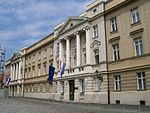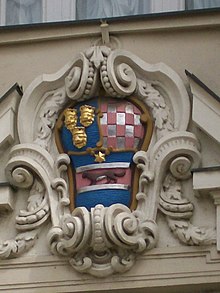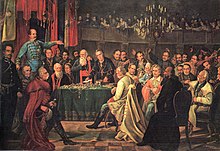Sabor
| logo | Parliament building |
|---|---|

|

|
| Basic data | |
| Seat: | Zagreb |
| Legislative period : | 4 years |
| MPs: | 151 |
| Current legislative period | |
| Last choice: | 11th September 2016 |
| Chair: |
President of Parliament Gordan Jandroković ( HDZ ) |
| Distribution of seats: |
|
| Website | |
| www.sabor.hr | |
Sabor ( Croatian for assembly , parliament , council ) is the name of the parliament of the Republic of Croatia with its seat in Zagreb . It is the central constitutional body in the Croatian political system . The unicameral system applies in Croatia . The Sabor legislative period lasts four years. Since October 14, 2016, the Sabor has been meeting in its ninth composition since the Republic of Croatia was founded .
At the time of the Habsburg Monarchy , Sabor was also the name of the assembly of estates of Croatia-Slavonia (until 1848), the limited representative state parliament (until 1918) and the provincial parliaments in the Austrian crown land of Dalmatia , in Istria (from 1861) and in Bosnia and Herzegovina (from 1910 ).
In Latin documents the sabor is referred to as plenum sborum , sborum sive parlamentum ; most frequently in Latin documents the translation is congregatio to find .
Suffrage
According to the Croatian constitution, the Sabor has between 100 and 160 MPs elected for four years. The number of its members of parliament is based on the size of the population and the proportional representation in order to reflect the will of the voters as precisely as possible. The Croatian Parliament currently has 151 members.
There are a total of 12 constituencies for the election of the Croatian Parliament. Croatia is legally divided into 10 electoral districts, in which 14 members were elected according to the proportional system . There is a five percent hurdle within the constituencies. There are also two separate constituencies:
Constituency XI : Parliamentary seats are also provided for Croatian citizens without permanent residence in Croatia, the exact number of which depends on the voter turnout in the Croatian diaspora (maximum 14, mostly 4-6). This constituency includes not only emigrants, but also many Croatians in Bosnia and Herzegovina.
Constituency XII : 8 seats are reserved for representatives of national minorities . Members of the minorities can either choose one of the majority parties or, alternatively, a representative of their minority on the respective list. The seats determined by voting are distributed as follows: 3 seats for Serbs and 1 seat each for Italians, for Hungarians, for Czechs and Slovaks, for Slovenes, Bosniaks, Montenegrins, Macedonians and Albanians and for other minorities (Germans, Ukrainians and Ruthenians, Romanians , Russians, Turks, Jews, Roma, Poles ...).
Powers
The Croatian parliament decides on the constitution and is the sole legislator, has budgetary rights, holds elections in accordance with the law, can initiate referendums and issue amnesties .
history
Middle Ages until 1848
The beginnings of the Croatian assembly of estates from which today's Sabor arose date back to the Middle Ages . Although Croatia had become part of the Hungarian St. Stephen's Crown in personal union in 1102 , separate meetings of the Croatian nobility often took place. In addition to this, the church was also represented in the Sabor. Shortly after taking office, every Hungarian king had a sabor convened, at which the Croatian estates paid homage to him.
As an assembly of estates under the Hungarian crown, the Sabor is documented for the first time in 1273 for Slavonia and 1351 for Croatia-Dalmatia . In 1527 the Croatian parliament of Cetin elected the Habsburg Ferdinand I independently of the Hungarians as king of Croatia. This was confirmed in writing in the Cetingrad charter .

Due to the loss of Croatian territory in the 15th and 16th centuries (Dalmatia to Venice, other areas to the Turks), the area from which the nobility came to the state parliament became smaller and smaller. In addition, the nobility of Slavonia separated from Croatia after 1526 and joined the Hungarian rival king Johann Zápolya . That is why separate state parliaments were held there until the Turkish conquest. After the reconquest of Slavonia by the Austrian armies in 1699, Slavonia was organized into counties, which were initially only represented in the Hungarian, but not in the Croatian parliament. They were later also represented in the Croatian parliament, but without losing direct representation in the Hungarian state, so that their status between Hungary and Croatia remained controversial. The Austrian military border was also withdrawn from the hands of the aristocratic Croatian national assembly. According to old tradition, the Croatian Landtag sent some envoys to the Hungarian Reichstag with voting rights .
In addition to secular ones, there were also church assemblies in Croatia. Some of them also had political significance, because areas were determined which fall under the jurisdiction of ecclesiastical power. Other reasons included the size of the ecclesiastical properties or the definition of the official language of worship.
1848 to 1918
In 1848 the Croatian Sabor played an important role in the revolution. The country and parliament were temporarily able to break away from Hungarian hegemony . The Sabor rejected the forced Magyarization of Croatia and gave Ban Josip Jelačić the power to act accordingly. The stands assembly was gradually transformed into a modern choice Parliament, wherein to the end of the Austrian-Hungary de facto no democratic election law applied. From 1849 the Sabor was again responsible for Slavonia, from 1881 also for the areas of the disbanded military border.

However, due to the Austro-Hungarian settlement (1867) and the supplementary Hungarian-Croatian settlement (1868), the powers of the Croatian parliament were very limited. The elections from 1868 to the end of the Austro-Hungarian monarchy were held according to an extremely restrictive census system that excluded the majority of the population from voting. In addition, the elections were held openly, and voters were exposed to massive electoral influence from the state administrative authorities. As head of the executive in Croatia-Slavonia, the Banus was primarily responsible to the Crown and the Hungarian Government, but not to the Sabor.
Dalmatia , which belonged to the Austrian half of the empire , had its own, the Dalmatian Landtag from 1861 to 1918 .
First Yugoslavia (1918 to 1945)
From 1919 to 1945 there was no Croatian parliament.

In autumn 1918, the last Sabor elected according to the old law decided to transfer his powers to the National Council of Slovenes, Croats and Serbs of the Habsburg Monarchy , which in turn decided to merge with Serbia to form the Kingdom of Serbs, Croats and Slovenes , later Yugoslavia .
As a result, the reconstitution of a Croatian Sabor, separated from the all-Yugoslav parliament, became a central demand of the Croatian opposition parties. In the spring of 1919 , the Croatian Peasant Party under Stjepan Radić unsuccessfully demanded that - analogous to the ratification of the state association by the Serbian parliament - the Sabor should also be convened again to discuss the ratification of the association. The members of the Croatian Peasant Party, elected in the elections to the Constituent Assembly of the Kingdom of Serbs, Croats and Slovenes, were constituted in protest against the limited powers of the Constituent Assembly and the non-recognition of a separate right of self-determination for Croatia as a separate Croatian parliament and drafted a constitution for a peasant republic of Croatia which of course remained mere paper in view of the real power relations.
In the agreement between the Yugoslav Prime Minister Dragisa Cvetkovic and the President of the Croatian Peasant Party, Vladko Maček , 1939, by an autonomous Banovina Croatia (kroat. Banovina Hrvatska) was created within Yugoslavia, was parallel to the election of the Yugoslav Parliament, the election of a Croatian Sabor provided. After the German invasion of Yugoslavia in 1941, this did not happen.
The Ustaša , who established the Independent State of Croatia (NDH) in 1941 under German-Italian occupation , attempted their rule in 1942 by convening a Sabor made up of former Sabor members from 1918, Croatian members of the Yugoslav parliament and other people they had chosen independently legitimize (this Sabor also included Branimir Altgayer and Ferdinand Gasteiger , two representatives of the German minority ). However, this Sabor was soon suspended and not reconvened, as a parliament had no function in the Independent State of Croatia, which was organized according to the leader principle.
Second Yugoslavia (from 1945)
In the Socialist Federal Republic of Yugoslavia from 1945 to 1990, the Sabor was the parliament of the People's Republic of Croatia or Socialist Republic of Croatia , in which the representation of different social groups was formally anchored in an institution, but for which no elections took place (no multi-party system).
Republic of Croatia (since 1990)
The reform movement, which was to lead to the breakup of Yugoslavia and the Yugoslav Wars, increased the importance of regional parliaments. The Croatian parliament was institutionally reorganized. It consisted of three chambers:
- the Sociopolitical Council (first chamber, was determined in free and equal elections)
- the council of municipalities
- the council of united labor
In April / March 1990 the first democratic elections were held in the Republic of Croatia. The HDZ achieved the absolute majority of the mandates. The newly elected Sabor adopted a new constitution at the end of 1990 and declared Croatia's independence in 1991.
A bicameral system was enshrined in the 1990 constitution. The Chamber of Deputies (Zastupnički dom) was the general legislative chamber. The House of Counties (Županijski dom) was supposed to represent the local authorities and had a predominantly advisory role. His sharpest weapon, a veto right against the first chamber, was used only once.
In 1997, 2000 and 2001 there were constitutional changes. In 2001 the second chamber was abolished, since then the Sabor has been a unicameral parliament .
literature
- Ivo Perić: Hrvatski državni sabor: 1848–2000 . 2 vols. Hrvatski institut za povijest, Hrvatski državni sabor, Dom i svijet, Zagreb 2000.
- Željko Sabol (Ed.): Croatian Parliament . Parliament of the Republic of Croatia et al., Zagreb 1995, ISBN 953-061331-8 .
- Mads Ole Balling: From Reval to Bucharest. Statistical-biographical handbook of the parliamentarians of the German minorities in East Central and Southeastern Europe 1919–1945. Volume 2: Hungary, Yugoslavia, Romania, Slovakia, Carpathian Ukraine, Croatia, Memelland Landtag, Silesian Landtag, comparative analysis, sources and literature, register. 2nd Edition. Documentation-Verlag, Copenhagen 1991, ISBN 87-983829-5-0 .
Web links
- http://www.sabor.hr/
- Sending out Austrian parliamentary correspondence. History of the Croatian Sabor
Individual evidence
- ↑ O Saboru. Retrieved May 27, 2020 (Croatian).
- ↑ Sabor. In: Croatian Encyclopedia . Lexicographical Institute Miroslav Krleža , accessed on January 20, 2018 .
- ↑ Article 71
- ↑ Izborne jedinice. Retrieved May 27, 2020 (Croatian).
- ↑ XI. izborna jedinica. Retrieved May 27, 2020 (Croatian).
- ↑ XII. izborna jedinica. Retrieved May 27, 2020 (Croatian).
- ↑ Holm Sundhaussen: Sabor . In: Edgar Hösch, Karl Nehring, Holm Sundhaussen (Hrsg.): Lexicon for the history of Southeast Europe . 2004, p. 590 .
- ↑ Hrvatski sabor - Povijest. Retrieved January 7, 2018 .
- ↑ Wolfgang Ismayr (Ed.): The political systems of Eastern Europe . 3rd, updated and expanded edition. VS - Verlag für Sozialwissenschaften, Wiesbaden 2010, ISBN 978-3-531-17181-4 , p. 786 ff . ( google.de - with the assistance of Solveig Richter and Markus Soldner).
Coordinates: 45 ° 48 ′ 59.1 ″ N , 15 ° 58 ′ 28.2 ″ E



